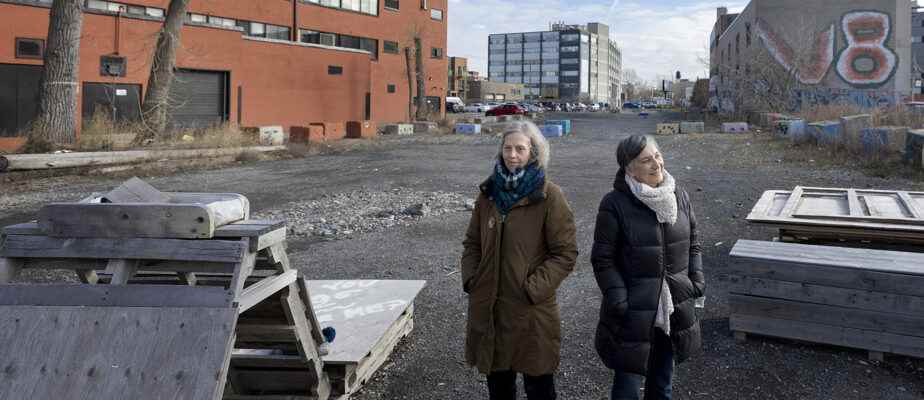One morning in May 2013, citizens of Mile-Ex, in Montreal, are in shock: at dawn, a real estate developer illegally razed fifty mature trees on a vacant lot long frequented by residents of the neighborhood.
This massive slaughter will be the trigger for an intense citizen mobilization that will last nearly 10 years. Until its happy ending last November, when the city council approved a development plan of 10.4 million for the creation of the Gorilla Park on this land.
Why this name? Activists used to call the wasteland “guerrilla park” because they felt they were engaged in urban guerrilla warfare for the creation of green space. Gradually, this name was transformed into “Park of the Gorillas”, and the name remained. Especially since the members of the AmiEs du parc des Gorilles committee, who call themselves the “gorillas”, want a natural and wild layout rather than an impeccable space with well-cut grass.

IMAGE PROVIDED BY THE CITY OF MONTREAL
The future development of the Gorilla Park
“It took a lot of energy to keep our dream for so long, the mountain was very big,” says Patricia Lucas, a retired eco-museum specialist who is part of the hard core of activists.
We were fighting against a big multinational, our project required millions of dollars, it involved the borough and the city center. But our group had a great cohesion, we were convinced, and we managed to get a lot of people on board with us.
Patricia Lucas, retired eco-museologist
“It took great determination, a lot of imagination and patience,” adds the painter Frances Foster, who is also a “gorilla” from the start. “We went to ask questions to the city council and the borough council, I don’t know how many times. »
Before 2013, many trees and tall grass stood on this wasteland, which overlooks rue Beaubien. The land belonged to Canadian Pacific. It is located in the extension of the old railway right-of-way which has become the Carrières cycle path. You could still see buried rails in some places.
After buying the land, the Olymbec company fells the trees, excavates the soil to decontaminate it and covers it with fine gravel. The promoter is acting without a permit, triggering the anger of citizens and elected municipal officials. However, he will not receive any penalty for this wild slaughter.
Frozen development
Since the owner had not yet submitted a project for the site, the borough of Rosemont–La Petite-Patrie acted quickly to impose a land reserve a few days later, with the aim of eventually purchasing the land.
“We were able to impose a reserve for park purposes. We had almost hidden in the premises of the district to make a special advice to make the reserve. It made it possible to freeze development on the ground, ”revealed the mayor of the borough, François Limoges, during the municipal council on November 21.
The game is not yet won: the piece of land still has to be acquired, which the borough cannot do itself.
It was then that the citizens began to hound the elected municipal officials, relentlessly for years, so that the project would not fall into oblivion.
“It gave rise to a magnificent mobilization of the group Les AmiEs du parc des Gorilles, who began to come to each council meeting”, recalled Mr. Limoges.
“We had to force the hand of the City to buy the land,” explains Simon Van Vliet, a member of the group.
Marching band and hens
During this period, the gorillas occupy the empty ground in various ways to be seen and heard, by holding gatherings, artistic demonstrations, meals between neighbors. “We even organized a community parade with a brass band and chickens,” laughs Patricia Lucas.
The cement blocks surrounding the site are painted with brightly colored patterns, a large mural, a collective work, brightens up a corner of the land, cleaning chores are organized.
In 2015, the AmiEs du parc des Gorilles even installed wooden bins in which they planted vegetables. They then received a formal notice from Olymbec’s lawyers, who ordered them to withdraw these arrangements.
Before the land was expropriated, it was difficult to mobilize people by telling them that there would eventually be a park. But we continued our activities on the site to appropriate it.
Simon Van Vliet, band member
After the City failed to negotiate the purchase of the land with Olymbec, it was not until 2017, shortly before the expiration of the land reserve, that the municipal administration expropriated the property. In 2018, Montreal paid the Superior Court, for the expropriated owner, a provisional indemnity of 1.9 million, but the final indemnity has not yet been established.
Following a period of public consultation, the City finally presented plans for the future park and approved funding for its development, nearly 10 years after the mobilization began.
Work will begin in the spring and the park should be accessible in the fall of 2024. It will be co-managed by the borough and the citizens.
“This park will have a very strong ecological vocation, will be a mini-forest in a mineralized area and a green lung for the district,” said François Limoges with satisfaction. He paid tribute to the “fight” carried out by the volunteers of the Friends of the Gorilla Park, in particular to Frances Foster “who has become the soul of this collective”, he said.
Learn more
-
- 10.4 million
- Development cost of the new Gorilla Park
Source: City of Montreal
